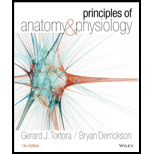
Principles of Anatomy and Physiology
14th Edition
ISBN: 9781118345009
Author: Gerard J. Tortora
Publisher: WILEY
expand_more
expand_more
format_list_bulleted
Concept explainers
Question
Chapter 14, Problem 19CP
Summary Introduction
To review:
The limbic system and its functions.
Introduction:
The limbic system refers to the ring of complex structures present on the cerebrum's inner border. It is also called the “emotional brain” as it is involved in wide range of emotions.
Expert Solution & Answer
Want to see the full answer?
Check out a sample textbook solution
Students have asked these similar questions
4. This question focuses on entrainment.
a. What is entrainment?
b. What environmental cues are involved in entrainment, and which one is most influential?
c. Why is entrainment necessary?
d. Assuming that a flash of darkness is an effective zeitgeber, what impact on circadian
rhythms would you expect to result from an event such as the 2024 solar eclipse (assume
it was viewed from Carbondale IL, where totality occurred at about 2 pm)? Explain your
reasoning. You may wish to consult this phase response diagram.
Phase Shift (Hours)
Delay Zone
Advance Zone
Dawn
Mid-day
Dusk
Night
Dawn
Time of Light Stimulus
e. Finally, give a real-world example of how knowledge of circadian rhythms and
entrainment has implications for human health and wellbeing or conservation biology.
This example could be from your reading or from things discussed in class.
Generate one question that requires a Punnet Squre to solve the question. Then show how you calculate the possibilities of genotype and phenotype
Briefly state the physical meaning of the electrocapillary equation (Lippman equation).
Chapter 14 Solutions
Principles of Anatomy and Physiology
Ch. 14 - Compare the sizes and locations of the cerebrum...Ch. 14 - Prob. 2CPCh. 14 - Prob. 3CPCh. 14 - Prob. 4CPCh. 14 - Prob. 5CPCh. 14 - 6. Where are the medulla, pons, and midbrain...Ch. 14 - Prob. 7CPCh. 14 - Prob. 8CPCh. 14 - Describe the location and principal parts of the...Ch. 14 - 10. Where do the axons of each of the three pairs...
Ch. 14 - Prob. 11CPCh. 14 - Prob. 12CPCh. 14 - Prob. 13CPCh. 14 - Define a circumventricular organ.Ch. 14 - 15. List and locate the lobes of the cerebrum. How...Ch. 14 - Prob. 16CPCh. 14 - Prob. 17CPCh. 14 - Prob. 18CPCh. 14 - Prob. 19CPCh. 14 - Prob. 20CPCh. 14 - Prob. 21CPCh. 14 - Prob. 22CPCh. 14 - How are cranial nerves named and numbered?Ch. 14 - Prob. 24CPCh. 14 - Prob. 25CPCh. 14 - Prob. 26CPCh. 14 - Prob. 27CPCh. 14 - Prob. 28CPCh. 14 - Prob. 29CPCh. 14 - Prob. 30CPCh. 14 - Prob. 31CPCh. 14 - Prob. 32CPCh. 14 - Prob. 33CPCh. 14 - 34. Where do the motor axons of the accessory (XI)...Ch. 14 - Prob. 35CPCh. 14 - Prob. 36CPCh. 14 - Prob. 37CP
Knowledge Booster
Learn more about
Need a deep-dive on the concept behind this application? Look no further. Learn more about this topic, biology and related others by exploring similar questions and additional content below.Similar questions
- Explain in a small summary how: What genetic information can be obtained from a Punnet square? What genetic information cannot be determined from a Punnet square? Why might a Punnet Square be beneficial to understanding genetics/inheritance?arrow_forwardIn a small summary write down:arrow_forwardNot part of a graded assignment, from a past midtermarrow_forward
- Noggin mutation: The mouse, one of the phenotypic consequences of Noggin mutationis mispatterning of the spinal cord, in the posterior region of the mouse embryo, suchthat in the hindlimb region the more ventral fates are lost, and the dorsal Pax3 domain isexpanded. (this experiment is not in the lectures).a. Hypothesis for why: What would be your hypothesis for why the ventral fatesare lost and dorsal fates expanded? Include in your answer the words notochord,BMP, SHH and either (or both of) surface ectoderm or lateral plate mesodermarrow_forwardNot part of a graded assignment, from a past midtermarrow_forwardNot part of a graded assignment, from a past midtermarrow_forward
arrow_back_ios
SEE MORE QUESTIONS
arrow_forward_ios
Recommended textbooks for you
 Human Physiology: From Cells to Systems (MindTap ...BiologyISBN:9781285866932Author:Lauralee SherwoodPublisher:Cengage Learning
Human Physiology: From Cells to Systems (MindTap ...BiologyISBN:9781285866932Author:Lauralee SherwoodPublisher:Cengage Learning Biology: The Dynamic Science (MindTap Course List)BiologyISBN:9781305389892Author:Peter J. Russell, Paul E. Hertz, Beverly McMillanPublisher:Cengage Learning
Biology: The Dynamic Science (MindTap Course List)BiologyISBN:9781305389892Author:Peter J. Russell, Paul E. Hertz, Beverly McMillanPublisher:Cengage Learning Human Biology (MindTap Course List)BiologyISBN:9781305112100Author:Cecie Starr, Beverly McMillanPublisher:Cengage Learning
Human Biology (MindTap Course List)BiologyISBN:9781305112100Author:Cecie Starr, Beverly McMillanPublisher:Cengage Learning

Human Physiology: From Cells to Systems (MindTap ...
Biology
ISBN:9781285866932
Author:Lauralee Sherwood
Publisher:Cengage Learning



Biology: The Dynamic Science (MindTap Course List)
Biology
ISBN:9781305389892
Author:Peter J. Russell, Paul E. Hertz, Beverly McMillan
Publisher:Cengage Learning

Human Biology (MindTap Course List)
Biology
ISBN:9781305112100
Author:Cecie Starr, Beverly McMillan
Publisher:Cengage Learning
